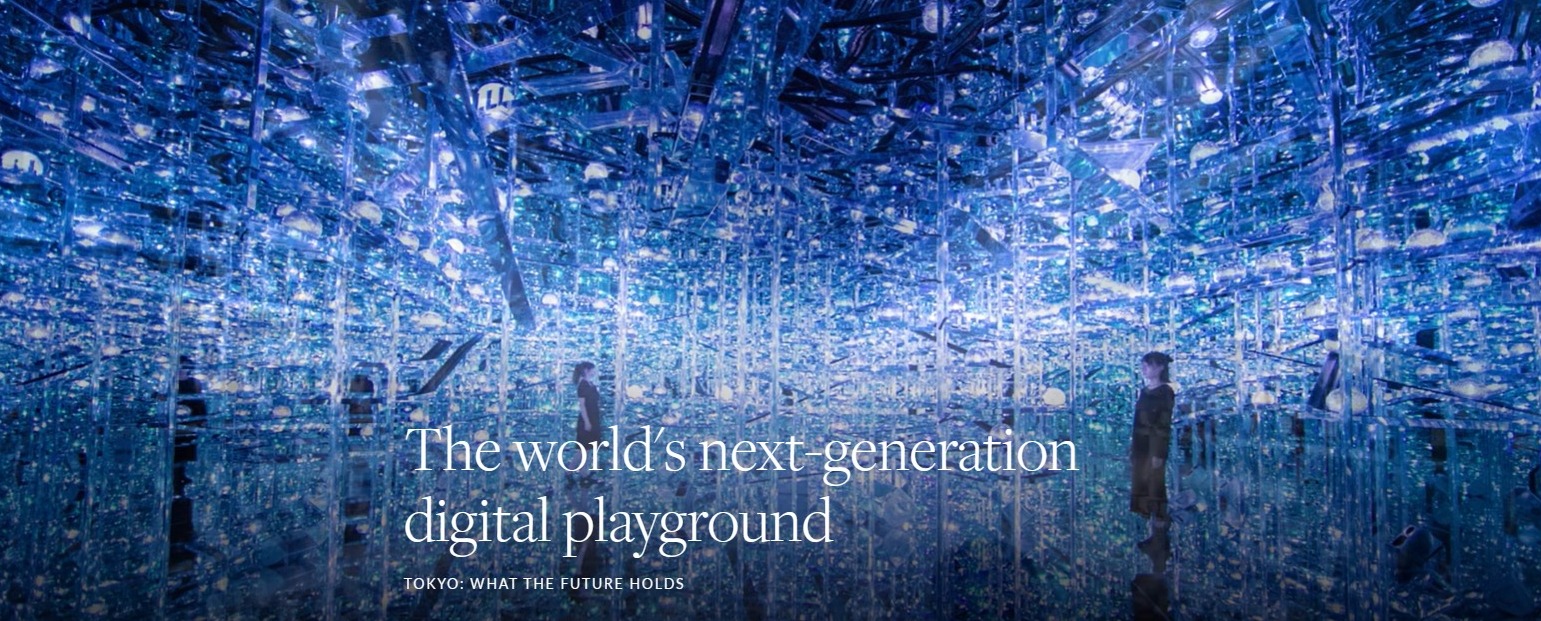
There are countless reasons to visit Tokyo. From its iconic neon nightscapes to world-class food, it is a city that embraces both its roots and the new. With its powers in technology, creativity and interest in social responsibility, Tokyo has augmented its digital art scene in ways more vibrant than before. Today, its digital spaces are pioneers for change.
You have just landed at Haneda Airport in Tokyo. You may have encountered a ‘washlet’ toilet in an immaculate restroom, then purchased a drink from a vending machine, and now you are off to the city centre on a train that arrived precisely on time. You board a taxi with doors that open automatically. Now, you unwind in a massage chair at your hotel, surrounded by relaxing LED lights. Tomorrow, you’ll board the bullet train and cross Japan in just a few hours.
Throughout its history, Japan has prioritised technological development to enhance people’s lives in functional ways. Now, this focus is shifting from everyday convenience to pushing the boundaries of ingenuity to create a better city for all.
Creative solutions for the greater good
Civic Creative Base Tokyo
In 2022, Civic Creative Base Tokyo (CCBT) launched in Shibuya after six months of intense preparation. The purpose was to create technology-based solutions to global concerns, while offering a fun and engaging space. CCBT organises exhibitions, workshops and meetups for children and adults through its five core programmes, all of which are free to the public.
The purpose of the project, according to the creative director Hideaki Ogawa, is to change Tokyo into “a better city” by combining creativity and technology. CCBT invites and pushes diverse creatives to digitally address social issues such as climate change, artificial intelligence and social inclusivity through its many activities, including the yearly open-call proposal competition ‘Art Incubation‘. Artists make creative artworks and share the process with the public through these programmes and events. CCBT, meanwhile, facilitates this process by supporting creators with venues and means to exhibit their works.
SnoezeLab. is one such creator that aims to build a project that can be enjoyed by everyone, including people with disabilities. It is led by Atsuko Hashimoto, who specialises in making ‘Snoezelen’ sensory rooms that serve as therapy for people with invisible disabilities, such as autism, dementia or brain injuries. SnoezeLab. aims to create Tokyo’s first digital sensory room and until its completion in March 2024, it will present in various stages including collaboration with parents of children with disabilities.
ELECTRONICOS FANTASTICOS!, led by the artist Ei Wada, is another promising initiative. It explores the theme of mass waste and creates something exciting from it. The project combines synthesising art, engineering, science and design to assemble a festival built from old appliances assembled by the public. Synflux, on the other hand, creates the next generation of sustainably-driven fashion by using avatars powered by the public. People can “wear” clothes on their avatars and better understand how technology can support sustainable fashion.
As CCBT strives to be an ever-evolving facility, like Tokyo itself, there’s plenty to see daily. What’s most appealing is that Tokyo’s denizens and travellers are offered a shared space to openly discuss essential questions for our existence in uncertain times and co-create creative solutions.
Creating opportunities for all
Avatar Robot Cafe DAWN
You are ready to order lunch when a friendly robot approaches you, explaining they will be responsible for your orders. They ask if it’s your first time at Avatar Robot Café DAWN. The robot waiter serves you in Tokyo via a remote operating software from Japan’s northernmost island, from the bed they’ve been on most of their life.
This large café in Nihonbashi, Tokyo has been designed with great care and is run by 70 robots controlled by people in remote locations. Most of them cannot work conventional jobs because of physical and family disabilities. At DAWN, employees are called “pilots” and run the café’s robot avatars using eye movements or software. They take orders, serve drinks and can be baristas. Some have assumed managerial positions. With the rise in overseas travellers, many have even gained proficiency in English in recent times.
Operated by the visionary tech company Ory Lab, the café explores new ways to promote social participation for Japan’s nearly 10 million residents (which is more than 7% of the population) who live with disabilities, and those who are unable to leave their homes or hospitals. The experiment benefits from the assistance of both visitors and workers. Visitors help the pilots develop important work skills such as communication and customer service, while the pilots apply their knowledge in their daily activities.
The café also offers a unique space for travellers to interact with people with diverse lifestyles from across Japan while sipping coffee in the company of likeable robots. “It’s very Japanese in essence,” says Ory Lab CEO and founder Kentaro Yoshifuji. “In Japan, like Doraemon and Astro Boy, robots and humans have always had amicable relationships.”
Staying active and engaged through technology
RED゜TOKYO TOWER
The launch of RED゜TOKYO TOWER, Tokyo’s first e-sports and gaming facility, was highly anticipated. Japan eSports Union (JeSU) was founded in 2018 to assist with Japan’s e-sports regulations relaxation and increase e-sports popularity. Their efforts paid off: the public’s perception of e-sports has remarkably improved, leading to a push for the industry’s growth. The same year saw Japan’s national high school e-sports championship come to life, and the number of teams climbed from 115 to 368 in 2021. In 2020, the Tokyo ESports Festa kicked off. Two years later, Tokyo at last welcomed RED.
Boasting 5,600 square metres, RED is currently one of the largest entertainment facilities in Japan. At Tokyo Tower, the facility is spread out over three floors, with dozens of the newest high-tech attractions, divided into three sections, suitable for all ages and all levels of gaming. The RED experience begins with the ‘Inspiration Zone’ on the third floor, letting visitors explore virtually with traditional Japanese VR games. Next is the ‘Attraction Zone’, hosting nearly 20 attractions from drone flying to virtual boccia and AR bouldering. The ‘Ultimate Zone’ then awaits, a grand e-sports lounge with regular tournaments. The same floor features e-boards, mind games and a hall using new technology for virtual fashion shows, concerts and more.
RED lets travellers experience the best of both worlds — the nostalgia of Japan with digital retro games and the latest game trends. Experience a safe, virtual tour of the best of Tokyo within a day, either by bike or from a drone. And with its fresh approach to digital activities, RED also challenges the age-old belief that gaming causes inactivity.
Toward a more borderless world
White / teamLab, Bubble Universe: Physical Light, Bubbles of Light, Wobbling Light, and Environmental Light © teamLab
teamLab Borderless, Japan’s first digital art museum, is moving to a new permanent location in Azabudai Hills, a large-scale new real estate complex in central Tokyo.
Scheduled to launch in February 2024, the new venue is more modern and will include new art pieces along with enhanced former favourites. Witness ‘Microcosmoses’ with multiple areas of hundreds of lights along tracks and the ‘Light Sculptures’ installation, comprising lights of varying colours and 3D shapes.
There will be a lot to immerse yourself in, promises Takashi Kudo, teamLab’s communications director and one of the art collective’s founding members. ‘Bubble Universe’ with countless spheres comprising lights of varying colours and shapes in 3D, and ‘Megalith Crystal Formation’ where blooming flowers and clashing waves represent the cycle of growth and decay, and essentially, rebirth.
Similar to what we’ve seen from teamLab in the past, but further evolved, the new venue’s artworks will transition between rooms and intermingle with other works, forming “one borderless world”.
This modern tech-driven ‘museum’ blends a gallery and a theme park, eschewing maps and descriptions. At teamLab Borderless, guests can be spectators, analysts, artists and visual interpreters. It provides the freedom of being part of a collective forming art, where each individual’s perception is important.
This will be even more evident at the new location, at the heart of Tokyo, Kudo hints. teamLab Borderless at Azabudai Hills will continue to examine how digital art can reshape the world and tackle arising issues. The works will delve further into the idea of a ‘world without boundaries,’ as well as the overflowing themes of art, space, nature and identity.
NewLatter Application For Free












































